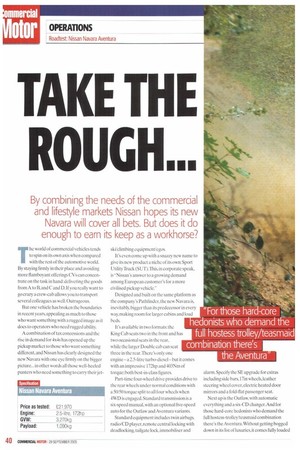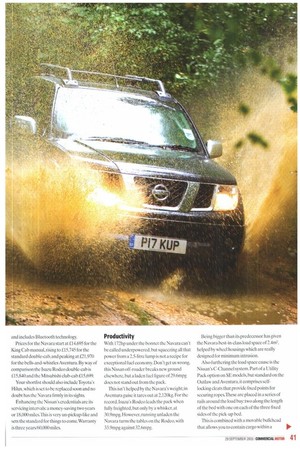TAKE THE ROUGH...
Page 42

Page 43

Page 44

If you've noticed an error in this article please click here to report it so we can fix it.
By combining the needs of the commercial and lifestyle markets Nissan hopes its new Navara will cover all bets. But does it do enough to earn its keep as a workhorse?
The world of commercial vehicles tends to spin on its own axis when compared with the rest of the automotive world. By staying firmly in their place and avoiding more flamboyant offerings CVs can concentrate on the task in hand: delivering the goods from A to B, and C and D. If you really want to go crazy a crew-cab allows you to transport several colleagues as well. Outrageous.
Rut one vehicle has broken the boundaries in recent years, appealing as much to those who want something with a rugged image as it does to operators who need rugged ability.
A combination of tax concessions and the rise in demand for 4x4s has opened up the pickup market to those who want something different, and Nissan has clearly designed the new Navara with one eye firmly on the bigger picture... in other words all those well-heeled punters who need something to cam, their jet ski/climbing equipment/egos.
It's even come up with a snaTiy new name to give its new product a niche of its own: Sport Utility Truck (SUT).This, in corporate speak. is "Nissan's answer to a growing demand among European customer's for a more civilised pickup vehicle."
Designed and built on the same platform as the company's Pathfinder, the new Navara is, inevitably, bigger than its predecessor in every way, making room for larger cabins and load beds.
It's available in two formats: the King Cab seats two in the front and has two occasional seats in the rear, while the larger Double cab can seat three in the rear.There's only one engine — a 2.5-litre turbo-diesel— but it comes with an impressive 172hp and 403Nm of torque; both best-in-class figures.
Part-time four-wheel drive provides drive to the rear wheels under normal conditions with a 50/50 torque split to all four wheels when 4WD is engaged. Standard transmission is a six-speed manual, with an optional five-speed auto for the Outlaw and Aventura variants.
Standard equipment includes twin airbags, radio/CD player, remote central locking with deadlocking, tailgate lock, immobiliser and alarm. Specify the SE upgrade for extras including side bars,17in wheels, leather steering wheel cover, electric heated door mirrors and a fold-flat passenger seat.
Next up is the Outlaw, with automatic everything and a six-CD changer. And for those hard-core hedonists who demand the full hostess-trolley/teasmaid combination there's the Aventura.Without getting bogged down in its list of luxuries, it comes fully loaded and includes Bluetooth technology.
Prices for the Navara start at £14,695 for the King Cab manual, rising to £15,745 for the standard double-cab, and peaking at £21970 for the bells-and-whistles Aventura. By way of comparison the 'SUM Rodeo double-cab is £15,840 and the Mitsubishi club-cab £15,699.
Your shortlist should also include Toyota's Hilux, which is set lobe replaced soon and no doubt has the Navara firmly in its sights.
Enhancing the Nissan's credentials are its servicing intervals: a money-saving two years or 18,000 miles."This is very un-pickup-like and sets the standard for things to come. Warranty is three years/60,000 miles.
Productivity
With 172hp under the bonnet the Navara can't be called underpowered. but squeezing all that power from a 2.5-litre lump is not a recipe for exceptional fuel economy. Don't get us wrong. this Nissan off-roader breaks new ground elsewhere, but a laden fuel figure of 29.6mpg does not standout from the pack.
This isn't helped by the Navara's weight; in Aventura guise it tares out at 2,120kg.For the record, Isuzu's Rodeo leads the pack when fully freighted, but only by a whisker, at 30.9mpg. However, running unladen the Navara turns the tables on the Rodeo, with 33.9mpg against 32.6mpg. Being bigger than its predecessor has given the Navara hest-in-class load space of 2.4m2, helped by wheel housings which are really designed for minimum intrusion.
Also furthering the load space cause is the Nissan's C-Channel system. Part of a Utility Pack option on SE models, but standard on the Outlaw and Aventura, it comprises selflocking cleats that provide fixed points for securing ropes.These are placed in a series of rails around the load hay: two along the length of the bed with one on each of the three fixed sides of the pick-up bed.
This is combined with a movable bulkhead that allows you to contain cargo within a specific area of the load bay. Carrying capacity is 1,123kg with the standard double-cab, falling to 1.090kg on the Aventura.
The rear passenger area is not a traditional storage area, but Nissan has incorporated 60/ 40 folding seats that recline to boost stowage space. Adding to the cabin's versatility is a fold-flat front passenger seat.
On the road With its wide stance and mix of sharp angles and gentle curves the Navara is a purposeful looking vehicle from most angles, and this bold approach is reflected in the way it drives.
Solid is the key word here, from impressive build quality to tightly controlled suspension characteristies.The ladder-frame chassis setup also contributes to this feeling of rigidity.
Perceived wisdom is that pickups skip and bounce on anything but smooth asphalt.The Navara challenges this "rule", offering a composed ride over undulations and even on corners, where the traditional elements of a skittish rear end and screeching tyres are done away with. Hard cornering will produce a degree of under steer, but nothing like we're used to. Impressive stuff.
The engine is also well developed. It has a commendable power output with, at 403Nm, a strong level of torque. It idles with controlled smoothness and revs with a satisfying growl all the way to the red line.
But we can't help but wonder if Nissan's claim of peak torque being on tap at a low 2,000rpm is entirely justified. Granted, it pulls well through the revs, but from low-down you have to work it when tackling inclines. upgrade it's hard to get a feel for the standard interior, but from looking at the general layout all the work has been done.You sit upright, naturally, but you can get a comfortable driving position thanks in no small part to a decent driving seat (the combination of leather and electric adjustment always helps). Add to this an adjustable (for rake) steering wheel and a dash that is ergonomically sound and you get a positive driving environment.
Storage is adequate, with side door pockets that incorporate small bottle/can holders and two glove boxes ahead of the front passenger (though the inclusion of the six-CD-changer and sat-nay reduced their capacity). Mind you, this space is usually taken by cup-holders and oddment trays so in most models it won't be a problem.
With increased dimensions comes improved rear seating space and this is a welcome addition. All double-cabs can carry three in the rear, but for how long will depend on their size and their patience.
The Nissan's rear is certainly an improvement, especially in the legroom department, which will be appreciated on long journeys. •






























































































































































































